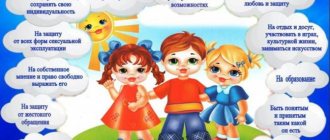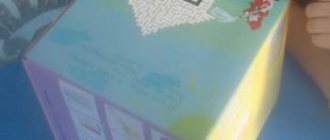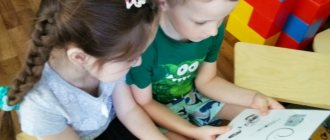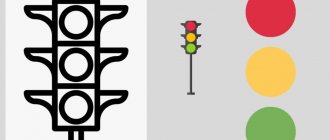Card index of didactic games on ecology for children of senior preschool age.
Transcript
1 Municipal autonomous preschool educational institution of the municipal formation of the city of Nyagan “Kindergarten of a general developmental type with priority implementation of activities in the cognitive and speech direction of children’s development 6 “Rowan” Card index of didactic games on ecology for children of senior preschool age. Nyagan, 2021 Developer: Lipsyuk Svetlana Vasilievna Teacher of the first qualification category
2 “Sun, air and water are our best friends!” Didactic. task: to consolidate children's knowledge about natural objects. Develop thinking, intelligence, auditory attention. Materials: ball The child who caught the ball says the word “air”, then must name the bird. For the word: “water” - an inhabitant of rivers, seas, lakes and oceans, for the word: “earth” - an animal that lives on earth, etc. "Natural and man-made world." Didactic task: to consolidate and systematize children’s knowledge about what nature gives to humans, what is created by human hands. Materials: ball.
3. Before the game, the teacher clarifies the children’s knowledge that the objects around us are made by human hands, or exist in nature, people use them; for example, forests, coal, oil, gas exist in nature, but houses and factories are created by humans. "What is made by man"? asks the teacher and throws the ball. “What is created by nature”? asks the teacher and throws the ball. Children catch the ball and answer the question. Those who cannot remember miss their turn. “Miracles in a bag” Didactic task: to teach children to describe objects perceived by touch, to guess them by their characteristic features. Materials: vegetables and fruits of characteristic shapes and varying densities: onions, beets, tomatoes, plums, apples, pears, etc. The teacher offers to take an object out of the bag, without immediately pulling it out, but after feeling it, name its characteristic features. "How will be correct". Didactic task: to consolidate children’s knowledge about nature. Develop cognitive activity, thinking Materials: subject pictures.
4 The teacher lays out object pictures on the table, names some property or sign, then the children must choose as many objects as possible that have this property. For example: “yellow” - these can be pictures of a leaf, zucchini, turnip. Or: “wet” - water, dew, cloud, fog, frost, etc. “Does the twig have its own children?” Didactic task: to consolidate children’s knowledge about tree fruits and leaves. Learn to select them according to their belonging to the same plant. Materials: leaves and fruits of trees and shrubs. Children look at pictures with leaves of trees and shrubs and name them. At the teacher’s suggestion: “Children, find your branches” - the children select the corresponding fruit for each leaf.
5 “Do you know plants” Didactic task: Find a plant by its name. The teacher names a houseplant, and the children must find it. The teacher gives a task to all children: “Who will quickly find the plant in our group room that I name?” Then asks some children to complete the task. If it is difficult for children to find the named plant in a large area of the room among many others, the game can be played by analogy with the previous ones, that is, the selected plants can be placed on the table. Then finding a plant in the room will become a more complicated version of the game. “Red, yellow, green” Didactic task: Find an object by similarity. Rule: Raise the piece of paper after the teacher names and shows it. Equipment: The game is played while walking. Select identical bouquets from 3-4 different leaves.
6 The teacher distributes bouquets to the children and keeps the same one for himself. Then he shows them some leaf, for example a maple one, and suggests: “One, two, three - show me this leaf!” Children raise their hand with a maple leaf. The game is repeated several times with the remaining leaves of the bouquet. “Where is whose house?” Didactic task: to consolidate children’s knowledge of animals and their homes in nature (insects, animals, amphibians, birds). Material: a tablet on which, on one side, various animals are depicted, and on the other, their homes, for example: a hole, a den, a beehive, a birdhouse, a nest. In the envelope on the back of the tablet there are arrows indicating the number of animals. Two or more children take part in the game. They take turns finding the animal on offer and using an arrow to identify its home. If the game actions are performed correctly, the child receives a chip. If the answer is incorrect, the move goes to the next player. The one who has the most chips at the end of the game wins.
7 “Who eats what?” Didactic task: to consolidate children’s knowledge about different types of animal nutrition (insects, amphibians, birds, animals) in nature. Material: a tablet on which different types of food for different animals are placed in a circle. There is a moving arrow in its center, and cards with illustrations of animals are placed in the envelope on the reverse side. The game involves two or more children. One by one, according to the teacher’s riddle, the children find the corresponding picture of the animal and use the arrow to indicate the type of food it eats. For the correct answer - a chip. The one who has the most chips at the end of the game wins. “What first, what then?” Didactic task: to consolidate children’s knowledge about the main stages of development and growth of living organisms (animals, plants, humans). Material: a set of cards on which the stages of development and growth of plants or animals (dandelion, peas, strawberries, frogs, butterflies, etc.), as well as humans (infancy, childhood, adolescence, adolescence, maturity, old age) are recorded. Option 1. The child is asked to arrange the cards in order of growth and development of a living creature (for example, cabbage butterfly: egg - caterpillar - pupa - butterfly) and tell what happened first and what came next. Option 2.
8 The teacher lays out the cards, deliberately making a mistake in their order. Children must correct her and explain the correctness of their decision.





